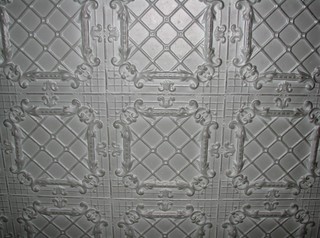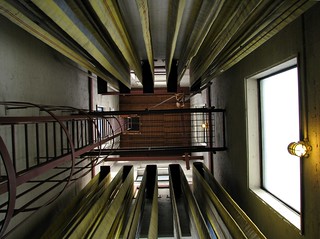Place: Fire Hall No. 5
Address: 845 Sargent Avenue
Opened: 1910
Architect: William and Alexander Melville
Contractor: John Saul
To keep up with the rapid expansion of residential development, the city announced the construction of a number of new fire halls in 1910. The site chosen for "Station No. 10", as it was originally called, was the corner of Sargent Avenue and Burnell Street.
Adjacent to the hall, a new 75 foot tall, fenced-in drill tower and yard would also be built. The tower was used by the fire chief to train new recruits and to call out on-shift firemen for practice drills. The existing tower, near No. 1 fire hall by city hall, now attracted too many onlookers, becoming a distraction for the men.
The fire hall was designed by architects Alexander and William Melville, Scottish brothers who were responsible for designing around a dozen Winnipeg fire halls between 1904 and 1912, most were a variation on the same master plan.
The tender for the construction of the hall, drill tower and Fire Hall No. 11 on Sinclair Street, were awarded to John Saul of Winnipeg in May 1910. Construction appears to have gone smoothly and they were open for business by the end of the year. The final cost of No. 5 was $20,000 plus an additional $3,000 for the tower. (The tower was destroyed along with a number of other city structures in a powerful wind storm in 1922.)
In the late 1920s, Fire Hall No. 5 lost two captains.
Robert E. Deegan began his career as a fireman in 1901 and worked his way up through the ranks until appointed captain in 1911 "due to his bravery and conscientiousness" said Fire Chief Buchanan. He served as captain at a number of halls, his last few years with No. 10. He fell ill at the end of summer and on November 10, 1926 died of an undisclosed illness at the age of 54.
In October 1929, Captain Malcolm Patterson of 703 Home Street died at the age of 48. He joined the department in 1904 and became a captain in 1919. No cause of death was given. After the funeral, his body was transported on a fire engine to the fireman's section of Brookside Cemetery for burial.
By the 1970s the building was obsolete. Some of the new equipment was larger than the original garage doors, there were health and safety concerns regarding engine exhaust and there was not enough space for modern communications equipment. The city's 1976 five-year capital budget called for the replacement of No. 5 in 1979 at an estimated cost of $500,000.
In February 1981 the city put out a tender for the design of a new fire hall and in May 1981 a council committee approved the demolition of the old one. The preferred location for the new hall was at the rear of the existing one, with an entrance off of Burnell Street, (presumably this was the site of the old drill area). Once completed, the old hall would be demolished to create a parking area.
This led to a battle between councilors, Burnell street residents, a local seniors organization and heritage advocates. Some thought that Burnell was too narrow for the trucks to enter and exit, seniors wanted the building kept for a seniors centre or other community facility and heritage advocates pointed out that the building could be renovated and a modern extension built to the rear, allowing the original structure to continue as a fire hall.
The city hired an architectural consultant to provide them with more options. In the end, the old hall was completely renovated and a modern wing was added to the rear which contains offices, living quarters, a kitchen and a room for drying firefighters' clothing. The price tag was about $725,000.

Tin ceiling, Fire Hall No. 5
Address: 845 Sargent Avenue
Opened: 1910
Architect: William and Alexander Melville
Contractor: John Saul
January 25, 1910, Winnipeg Tribune
To keep up with the rapid expansion of residential development, the city announced the construction of a number of new fire halls in 1910. The site chosen for "Station No. 10", as it was originally called, was the corner of Sargent Avenue and Burnell Street.
Adjacent to the hall, a new 75 foot tall, fenced-in drill tower and yard would also be built. The tower was used by the fire chief to train new recruits and to call out on-shift firemen for practice drills. The existing tower, near No. 1 fire hall by city hall, now attracted too many onlookers, becoming a distraction for the men.
October 1912
The fire hall was designed by architects Alexander and William Melville, Scottish brothers who were responsible for designing around a dozen Winnipeg fire halls between 1904 and 1912, most were a variation on the same master plan.
The tender for the construction of the hall, drill tower and Fire Hall No. 11 on Sinclair Street, were awarded to John Saul of Winnipeg in May 1910. Construction appears to have gone smoothly and they were open for business by the end of the year. The final cost of No. 5 was $20,000 plus an additional $3,000 for the tower. (The tower was destroyed along with a number of other city structures in a powerful wind storm in 1922.)
October 16, 1913, Winnipeg Tribune
The firemen of No. 5 are credited with saving hundreds of buildings and lives over the years, but one of the first times they made news was due to an accident to one of their own.
Sydney Ross, a fire wagon driver, was excercizing a team of horses at around 8 am on Thursday, October 16, 1913. He was riding a horse slowly, back and forth in front of the station when it began rearing, throwing him to the ground. He suffered a broken leg and concussion and was taken to St. Boniface hospital to recover.
November 11, 1926, Winnipeg Tribune
In the late 1920s, Fire Hall No. 5 lost two captains.
Robert E. Deegan began his career as a fireman in 1901 and worked his way up through the ranks until appointed captain in 1911 "due to his bravery and conscientiousness" said Fire Chief Buchanan. He served as captain at a number of halls, his last few years with No. 10. He fell ill at the end of summer and on November 10, 1926 died of an undisclosed illness at the age of 54.
October 21, 1929, Winnipeg Tribune
In October 1929, Captain Malcolm Patterson of 703 Home Street died at the age of 48. He joined the department in 1904 and became a captain in 1919. No cause of death was given. After the funeral, his body was transported on a fire engine to the fireman's section of Brookside Cemetery for burial.
Hose drying tower, Fire hall No. 5
By the 1970s the building was obsolete. Some of the new equipment was larger than the original garage doors, there were health and safety concerns regarding engine exhaust and there was not enough space for modern communications equipment. The city's 1976 five-year capital budget called for the replacement of No. 5 in 1979 at an estimated cost of $500,000.
In February 1981 the city put out a tender for the design of a new fire hall and in May 1981 a council committee approved the demolition of the old one. The preferred location for the new hall was at the rear of the existing one, with an entrance off of Burnell Street, (presumably this was the site of the old drill area). Once completed, the old hall would be demolished to create a parking area.
May 5, 1981, Winnipeg Free Press
This led to a battle between councilors, Burnell street residents, a local seniors organization and heritage advocates. Some thought that Burnell was too narrow for the trucks to enter and exit, seniors wanted the building kept for a seniors centre or other community facility and heritage advocates pointed out that the building could be renovated and a modern extension built to the rear, allowing the original structure to continue as a fire hall.
The city hired an architectural consultant to provide them with more options. In the end, the old hall was completely renovated and a modern wing was added to the rear which contains offices, living quarters, a kitchen and a room for drying firefighters' clothing. The price tag was about $725,000.

Tin ceiling, Fire Hall No. 5
Fire Hall No. 5 has been the oldest operable fire hall in the city since the closure and subsequent demolition of No. 7 on Burrows Avenue at Aikins in the early 2000s. It is not designated a heritage building, though in November 2014 it was added to the Historical Building Commemorative List.
Related:
Winnipeg Fire Museum website
The Fire Halls of A and W Melville West End Dumplings
The Fire Halls of A and W Melville West End Dumplings
Former Fire Hall no. 11, Sinclair Street, built the same year as No. 5
(source: City of Winnipeg)
Call for tenders, Fire Hall No. 10
April 28, 1910, Winnipeg Tribune
Call for tenders, replacement fire hall
February 14, 1981, Winnipeg Free Press
(source: City of Winnipeg)
Call for tenders, Fire Hall No. 10
April 28, 1910, Winnipeg Tribune
Call for tenders, replacement fire hall
February 14, 1981, Winnipeg Free Press









No comments:
Post a Comment